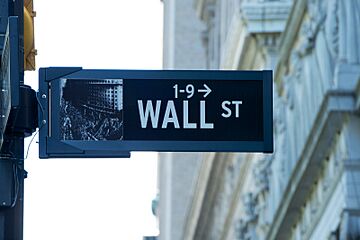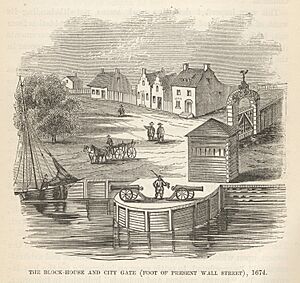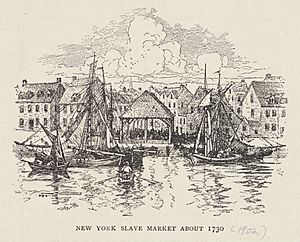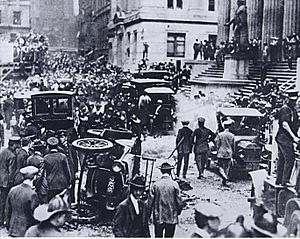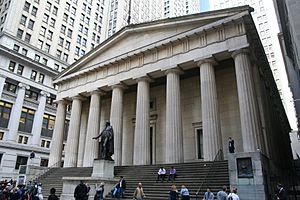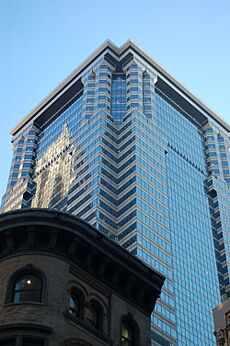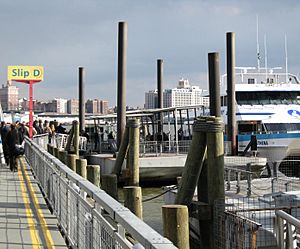Wall Street facts for kids
| Het Cingel (Dutch) | |
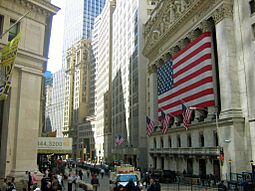
The New York Stock Exchange Building on Broad Street (right) as seen from Wall Street. 23 Wall Street, a former financial headquarters, is on the far left.
|
|
| Length | Expression error: Unrecognized punctuation character ",". ft (Expression error: Unexpected < operator. m) |
|---|---|
| West end | Broadway |
| East end | South Street |
Wall Street is a famous street in the Financial District of Lower Manhattan in New York City. It stretches for about eight city blocks, from Broadway in the west to South Street and the East River in the east. The street is just under 2,000 feet long.
The name "Wall Street" has become a way to refer to the entire financial markets of the United States. It also stands for the American financial industry, New York's financial businesses, or the Financial District itself. Because of Wall Street, New York is known as a top global fintech and financial center.
This street was first called Het Cingel (meaning "the Belt") by the Dutch in the 1600s. At that time, it was part of New Amsterdam. A real city wall stood here from 1653 to 1699. In the 1700s, it was a place for trading goods and stocks. New York's city hall, later called Federal Hall, was also built here in 1703.
By the early 1800s, more businesses than homes filled the area. Wall Street became the heart of New York's financial world. In the 1900s, tall buildings called early skyscrapers were built here. These included 40 Wall Street, which was once the world's tallest building. Wall Street is also close to many subway stations and ferry stops.
The Wall Street area is home to the New York Stock Exchange. This is the world's largest stock exchange based on the total value of its companies. You can also find the Federal Reserve Bank of New York here, along with many banks and insurance companies. Other stock and commodity exchanges have also been near Wall Street. The money-related activities on Wall Street affect people all over the world.
Contents
History of Wall Street
Early Beginnings

The Dutch first called this street Het Cingel, meaning "the Belt." This was also the name of a wall and canal in Amsterdam. After the English took over in 1664, they renamed the area "New York." In 1665, they called the street Het Cingel ofte Stadt Wall, meaning "the Belt or the City Wall." New York Governor Thomas Dongan likely gave the street its official name, Wall Street, in 1686.
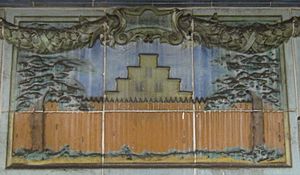
The first wall was built in 1653 by Peter Stuyvesant. He was the leader of the Dutch West India Company. This happened during the first Anglo-Dutch War. Stuyvesant worried about an attack from English colonies in New England. He ordered a ditch and a wooden fence, called a palisade, to be built. This wall marked the northern edge of the New Amsterdam settlement.
The wall was made of dirt and wooden planks. It was about 15 feet wide and 9 feet tall, stretching 2,340 feet long. Both enslaved Africans and white colonists were made to work on building it. Stuyvesant ordered everyone to help dig the ditch and build the fort.
The first Anglo-Dutch War ended in 1654. But the wall was made stronger over time. It protected against attacks from Native Americans, pirates, and the English. The English also improved the wall after they took over in 1664. The Dutch did the same when they briefly retook the city from 1673 to 1674. By the late 1600s, the wall surrounded most of the city. It had two large stone forts, called bastions, on its northern side. The Dutch named these "Hollandia" and "Zeelandia."
The wall started at Hanover Square on Pearl Street, which was the shoreline then. It crossed an Indian path, now Broadway. It ended at another shoreline, now Trinity Place. There was a gate at Broadway and another at Pearl Street. The wall was taken down in 1699 because the city had grown past it. A new City Hall was built at Wall and Nassau in 1700. Stones from the old wall's forts were used for its foundation.
In 1711, the New York City Common Council made a spot at the foot of Wall Street an official place for trading enslaved Africans and Native Americans. This trading spot operated from 1711 to 1762. It was at the corner of Wall and Pearl Streets. The city government made money from these sales by collecting taxes on each person traded there.
In these early days, traders met in different spots to buy and sell shares and bonds. They eventually formed two groups: auctioneers and dealers. In the late 1700s, traders met under a buttonwood tree at the foot of Wall Street to trade stocks. Being close to each other helped them. In 1792, these traders made an official agreement called the Buttonwood Agreement. This was the start of the New York Stock Exchange. The agreement aimed to make trading more organized and fair.
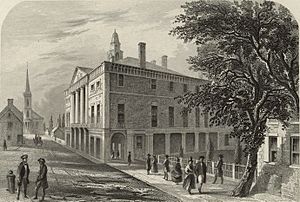
In 1789, Wall Street was the site of the first U.S. presidential inauguration. George Washington took his oath of office on the balcony of Federal Hall on April 30, 1789. The Bill of Rights was also passed here. Alexander Hamilton, the first Treasury secretary, is buried in the cemetery of Trinity Church. So is Robert Fulton, famous for his steamboats.
The 1800s: Growth and Change
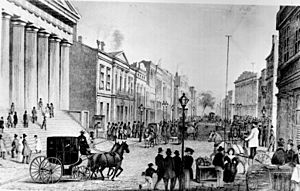
In the early 1800s, both homes and businesses were in the Wall Street area. But businesses quickly became more common. The opening of the Erie Canal in the early 1800s brought a huge boost to New York City. This canal gave the city direct water access to the Great Lakes. Wall Street then became known as the "money capital of America."
Historian Charles R. Geisst noted a constant "tug-of-war" between Wall Street businesses and the government in Washington, D.C.. During the 1800s, Wall Street mostly developed its own unique ways of doing business with little outside interference.
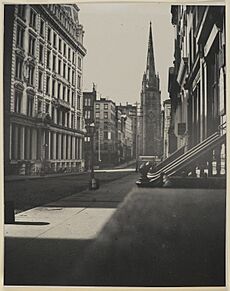
By the 1840s and 1850s, most people living in the area moved further uptown. This was because of the increasing business activity. The Civil War greatly expanded the northern economy. This brought more wealth to cities like New York. New York became the nation's banking center, connecting "Old World capital and New World ambition." Important figures like J. P. Morgan created large companies. John D. Rockefeller's Standard Oil also moved to New York City.
Between 1860 and 1920, the economy shifted from farming to industry to finance. New York kept its leading role through these changes. It was second only to London as the world's financial capital.
In 1884, Charles Dow started tracking stocks. He began with 11 stocks, mostly railroads. He looked at their average prices. Some companies included were American Tobacco Company and General Electric. If the average prices went up consistently, he called it a bull market. If they dropped, it was a bear market. He added up prices and divided by the number of stocks to get his Dow Jones Industrial Average. Dow's numbers became a useful way to understand the entire stock market. In 1889, his stock report, Customers' Afternoon Letter, became The Wall Street Journal. This influential business newspaper was named after the street.
The 1900s: Challenges and Recovery
Early 1900s Events
Writer John Brooks believed the early 1900s were Wall Street's best years. The building at 23 Wall Street, headquarters of J. P. Morgan & Company, was called The Corner. It was seen as the very center of financial America and even the world.
Wall Street's relationship with the government has changed over time. In 1913, stock clerks protested a proposed tax on stock transfers. At other times, city and state leaders have offered tax breaks to keep financial firms in the city. A post office was built at 60 Wall Street in 1905. During World War I, there were efforts to raise money for groups like the National Guard.
On September 16, 1920, a powerful bomb exploded near Wall and Broad Street. This was a very busy corner. The explosion killed 38 people and seriously hurt 143. The people responsible were never found. This event helped increase fears of communism at the time. A newspaper reported that the area was a "wreck" after the blast.
Market Changes and Regulation
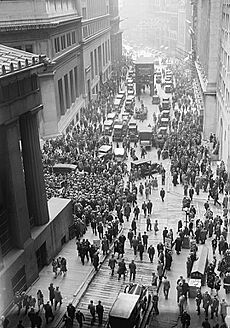
September 1929 was the peak of the stock market. On October 24, stock values suddenly dropped. The stock market crash of 1929 led to the Great Depression. During this time, many people lost their jobs, and businesses struggled. Wall Street "paid a heavy price" and became less important in American life.
During the 1930s and 1940s, there was less focus on Wall Street. The government put rules on buying stocks with borrowed money. But these rules slowly became less strict. By the 1960s, the economy recovered. Trading activity grew, sometimes causing delays in processing paperwork.
In the 1970s, the financial industry faced losses. The government offered temporary help. New rules were made, like the Securities & Exchange Commission ending fixed commissions. This made brokers compete more for business. In 1975, a rule requiring most stock trades to happen on the NYSE floor was removed. This allowed for more electronic trading. These changes made it easier and cheaper for more people to invest in the stock market.
The 1980s, under President Ronald Reagan, saw a renewed focus on capitalism and business. Industries like telecommunications and aviation were less regulated. The economy grew again after a slow period.
In 1987, the stock market fell sharply. The area around Wall Street lost many jobs. Because telecommunications costs were dropping, banks and brokerage firms could move to cheaper places. The NYSE itself considered moving. But in 1998, the city made a $900 million deal to keep the NYSE in the Financial District.
The 2000s: New Challenges
In 2001, the NYSE was still seen as the world's "largest and most prestigious stock market." When the World Trade Center was destroyed on September 11, 2001, the attacks damaged communication networks and many buildings in the Financial District. Wall Street buildings had little physical damage. The NYSE reopened on September 17, just days after the attack.
After September 11, the financial industry faced a downturn. To protect against future attacks, parts of Wall Street were permanently closed to cars. These areas became public spaces for people to walk. Concrete barriers, called bollards, were put in place. Over time, these were made to look more appealing.
The years from 2006 to 2010 were challenging for the economy. Many people blamed Wall Street for some of the problems. However, experts noted that many factors were involved. The U.S. government helped banks and financial companies with money. This was called the Troubled Asset Relief Program. This help was controversial, but it was seen as necessary to prevent a deeper economic crisis.
By 2010, Wall Street firms were "getting back to their old selves." The area saw a "phoenix-like resurrection," with new homes, businesses, shops, and hotels. It became the third-largest business district in the country.
In September 2011, the Occupy Wall Street movement began. People protested in parks near Wall Street. They were unhappy with the financial system.
On October 29, 2012, Hurricane Sandy caused major flooding in New York and New Jersey. Wall Street was affected. The NYSE closed for two days, which was rare for weather-related reasons.
Wall Street Architecture
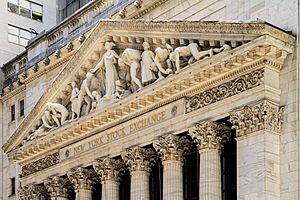
The buildings on Wall Street often have grand designs from the Gilded Age. Older skyscrapers feature detailed fronts, which are less common in modern buildings. Many important landmarks on Wall Street were once bank headquarters. These include:
- Federal Hall National Memorial (26 Wall Street): Built from 1833–1842. It was once a customs house and treasury. Now, it is a national monument.
- 55 Wall Street: Built from 1836–1841 as a four-story exchange. It became a customs house and was expanded to eight stories in 1907–1910.
- 14 Wall Street: A 32-story skyscraper with a stepped pyramid top. It was built from 1910–1912 and expanded later. It was originally the Bankers Trust Company Building.
- 23 Wall Street: A four-story building from 1914. Known as the "House of Morgan," it was a key address in American finance. Damage from the 1920 bombing is still visible.
- 48 Wall Street: A 32-story skyscraper built from 1927–1929. It was the Bank of New York & Trust Company Building.
- 40 Wall Street: A 71-story skyscraper built from 1929–1930. It was the Bank of Manhattan Company Building and later became the Trump Building.
- 1 Wall Street: A 50-story skyscraper built from 1929–1931. It was known as the Irving Trust Company Building.
- 60 Wall Street: Built in 1988. It was once J.P. Morgan & Co. headquarters and is now the U.S. headquarters of Deutsche Bank. It is the last major investment bank headquarters on Wall Street.
Another key building is the New York Stock Exchange Building at Broad Street. It houses the New York Stock Exchange, the world's largest stock exchange. City leaders know its importance. In 1998, they offered tax breaks to keep it in the Financial District. Plans to rebuild were delayed by the September 11 attacks. The exchange still operates at the same location. It uses a lot of technology and data. For example, the trading floor needs a lot of electricity and miles of fiber-optic cable.
Why Wall Street Matters
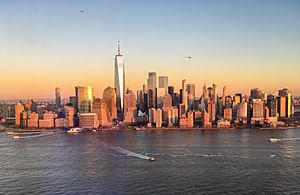
An Economic Powerhouse
Impact on New York
Finance professor Charles R. Geisst said the exchange is "deeply connected to New York's economy." The money earned on Wall Street, from salaries and taxes, is a big part of the economy for New York City and the surrounding area. New York City is called the world's most powerful economic city and a leading financial center because of Wall Street. If Wall Street's economy slows down, it can have a big effect on the local and regional economies.
In 2007, the financial services industry made $70 billion in profit. This accounted for 22 percent of the city's income. Another estimate from 2006 said that this industry makes up 9% of the city's jobs and 31% of its tax money. In 2012, the city's securities industry had 163,400 jobs. It made up 5 percent of private sector jobs in New York City. It also contributed 8.5 percent ($3.8 billion) of the city's tax revenue. The average salary in this industry was $360,700.
The seven largest Wall Street firms in the 2000s included JPMorgan Chase, Citigroup, and Goldman Sachs. During the economic downturn of 2008–10, some of these firms, like Lehman Brothers, went out of business. Others, like Bear Stearns and Merrill Lynch, were bought by other companies. These events greatly changed Wall Street. Since New York's financial industry provides a lot of the city's income and tax revenue, the downturn had big effects on government budgets.
Wall Street vs. Midtown Manhattan
The New York Stock Exchange used to require brokerage firms to have offices near Wall Street. This was so clerks could deliver paper stock certificates. By 1911, some financial dealings were already happening in Midtown. But as technology improved, computers and telecommunications replaced paper. This meant firms no longer needed to be so close to Wall Street. Many financial companies moved to Midtown Manhattan, which was only about 4 miles away.
However, the New York Stock Exchange Building remains a key attraction for Wall Street. Some older firms, like Goldman Sachs, have stayed loyal to the Financial District. New firms, like Deutsche Bank, have also chosen offices there. Face-to-face trading between buyers and sellers is still important at the NYSE. It helps to have all the people involved in a deal, like investment bankers, lawyers, and accountants, close by.
Impact on New Jersey
Wall Street's economic effects also reach beyond New York City, especially into New Jersey. Many "back office" jobs in the financial services industry are in New Jersey. In 2009, Wall Street-related jobs paid almost $18.5 billion in the state. This industry added $39.4 billion to New Jersey's economy that year. Jersey City has a large number of Wall Street jobs. In 2008, these jobs made up one-third of the private sector jobs in Jersey City.
New Jersey has also become a major technology hub for Wall Street. Many stock trades in the U.S. happen in data centers located in North and Central Jersey. A lot of the work for clearing and settlement of securities is also done in New Jersey. This includes most of the workers for the Depository Trust Company, which holds U.S. securities. However, relying on Wall Street jobs can be risky for New Jersey. The state lost many financial services jobs after the 2007–2010 economic crisis.
Other Financial Centers
New York Times analyst Daniel Gross noted that the NYSE is no longer the only center of global finance. Other large investment companies are in places like Pennsylvania, Los Angeles, and Boston. Trading and money management are now global. Huge amounts of money are also held overseas in places like Switzerland, Shanghai, and by governments in Singapore and Dubai.
For example, an alternative trading platform called BATS is based in Kansas City. It quickly gained a 9 percent share of the U.S. stock trading market. This company has computers in U.S. state of New Jersey and only two salespeople in New York City. Most of its employees work in Kansas.
Wall Street in Public View
A Symbol of Finance
Wall Street often represents financial and economic power. To Americans, it can sometimes stand for powerful groups and politics. Its role has been debated throughout U.S. history, especially since the late 1800s. Wall Street has become a symbol of a country and economic system built on trade, capitalism, and new ideas.
The term "Wall Street" is often used to mean the U.S. financial markets or the American financial industry. It can sometimes be used in a negative way. During the 2007–2010 economic crisis, Wall Street finance was blamed as one cause. The U.S. government helped banks with taxpayer money. This help was criticized by many people.
When large companies were found guilty of fraud, Wall Street was often blamed. This happened even if these companies were not located on Wall Street itself. Some people felt that new laws made business harder. Groups trying to influence Washington lawmakers often say they are on the side of "Main Street" (everyday people) rather than "Wall Street" (big finance).
When the United States Treasury helped large financial firms, there was a lot of public anger. This was especially true when reports showed that money meant to help the economy was used for employee bonuses. Some critics argued that it was wrong for Wall Street to make "massive profits and bonuses" after being saved by taxpayer money.
However, some in the financial industry believe they are unfairly criticized. They see banks as the engines that power the economy. They believe that taking risks is important for economic growth.
Images of Wall Street and its people have been very influential. The 1987 film Wall Street created the famous character Gordon Gekko. He said, "greed is good," a phrase that became well-known. This character was based on real people in finance. The film unexpectedly led many young people to want careers on Wall Street.
Wall Street in Popular Culture
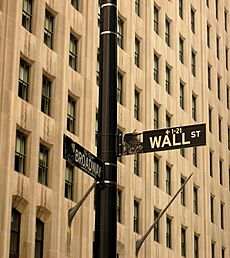
- Herman Melville's short story "Bartleby, the Scrivener" (1853) is called "A Story of Wall Street." It shows the isolating feelings of working there.
- Many events in Tom Wolfe's 1987 novel The Bonfire of the Vanities happen on Wall Street.
- The film Wall Street (1987) and its sequel Wall Street: Money Never Sleeps (2010) show common ideas about Wall Street. These include ideas about dishonest business deals.
- In the Star Trek universe, the Ferengi are said to visit Wall Street. They see it as a holy place for business.
- On January 26, 2000, the band Rage Against the Machine filmed a music video on Wall Street. The New York Stock Exchange closed early that day.
- The 2013 film The Wolf of Wall Street is a dark comedy. It is about Jordan Belfort, a stockbroker who committed fraud on Wall Street.
Famous People Connected to Wall Street
Many people linked to Wall Street have become famous. Some, like hedge fund manager Ray Dalio, are known for their smart investment strategies. Others, like Ivan Boesky and Bernie Madoff, are remembered for their notable mistakes or scandals.
Getting Around Wall Street
Wall Street has always been a place where many people travel to for work. Because of this, a lot of transportation options have been built. Pier 11, near the east end of Wall Street, is a busy terminal for several ferry services. The Downtown Manhattan Heliport also serves the area.
There are three New York City Subway stations under Wall Street:
- Wall Street station at William Street (2 and 3 train)
- Wall Street station at Broadway (4 and 5 train)
- Broad Street station at Broad Street, with an entrance at Wall Street (J and Z train)
No bus routes run directly on Wall Street. However, two routes cross it: the M15, M15 SBS on Water Street and the downtown M55 on Broadway.
From 1934 to the mid-1980s, the Wall Street Skyport was a seaplane base. It was mainly used by people commuting from the suburbs.
See also
 In Spanish: Wall Street para niños
In Spanish: Wall Street para niños
- Main Street
- American business history
- Dow Jones Industrial Average
- Economy of New York City
- List of Financial Districts
- Wall Street Historic District (Manhattan)


